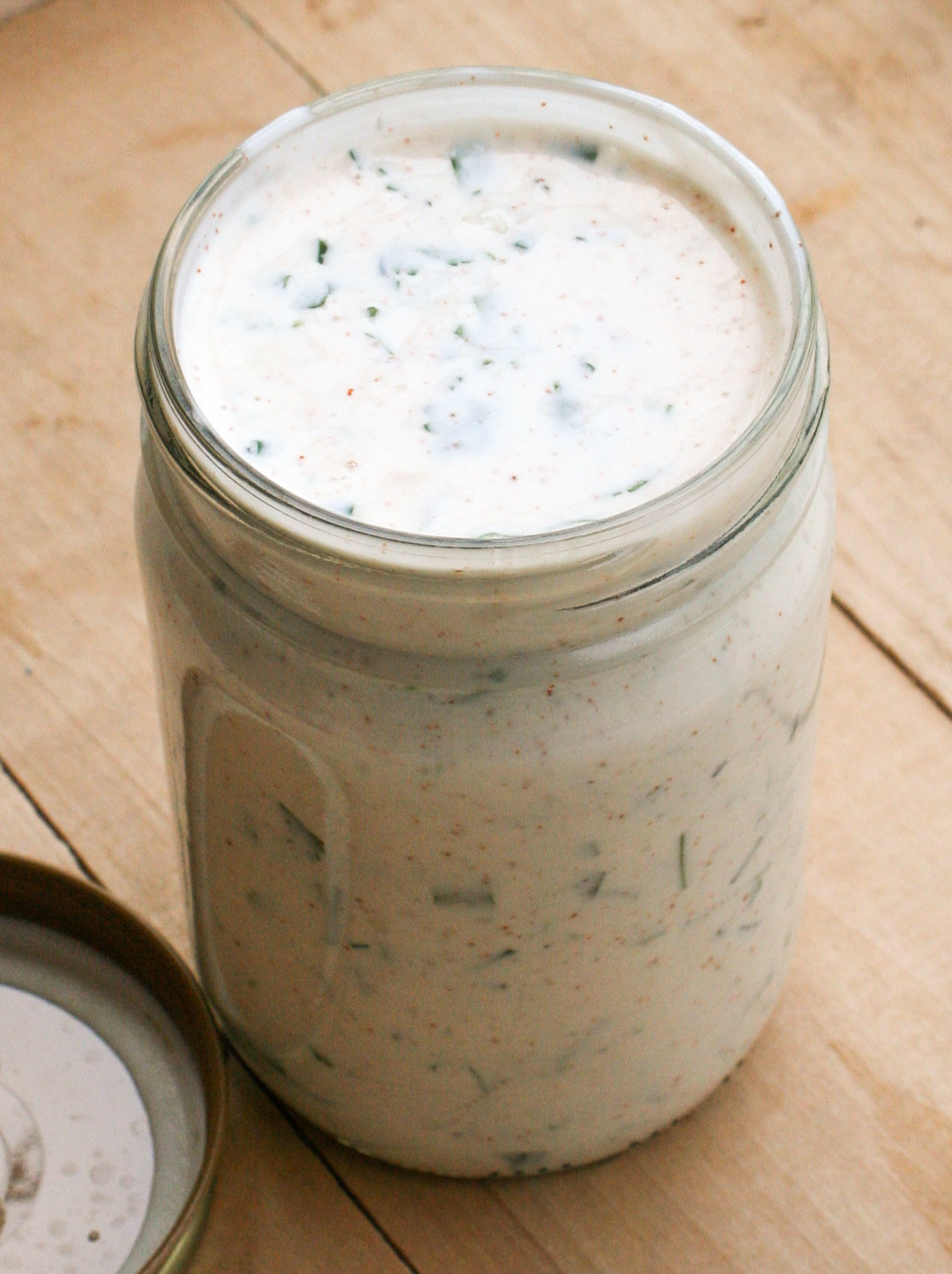
Ranch dressing
Ranch dressing is a savory, creamy American salad dressing usually made from buttermilk, salt, garlic, onion, mustard, herbs (commonly chives, parsley and dill), and spices (commonly pepper, paprika and ground mustard seed) mixed into a sauce based on mayonnaise or another oil emulsion. Sour cream and yogurt are sometimes used in addition to, or as a substitute for, buttermilk and mayonnaise.
Type
Steve Henson
Early 1950s
Ranch has been the best-selling salad dressing in the United States since 1992, when it overtook Italian.[1] It is also popular in the United States and Canada as a dip, and as a flavoring for potato chips and other foods. In 2017, 40% of Americans named ranch as their favorite dressing, according to a study by the Association for Dressings and Sauces.[2]
History[edit]
In 1945, Thayer, Nebraska native Steve Henson (1918–2007) moved with his wife to the Anchorage, Alaska, area, where he worked as a plumbing contractor. While there, he invented a new salad dressing.
Henson retired from plumbing at age 35, and moved with his wife to Santa Barbara County, California. In 1956, he purchased a guest ranch in San Marcos Pass and renamed it Hidden Valley Ranch.
Henson served the salad dressing he had created at the ranch. He also mixed a batch for his friend, Audrey Ovington, owner of Cold Spring Tavern, which became the first commercial customer for the dressing. By 1957, Henson began selling packages of dressing mix in stores.[3]
Henson began selling the packages by mail for 75 cents a piece, and eventually devoted every room in his house to the operation. By the mid-1960s, the guest ranch had closed, but Henson's "ranch dressing" mail-order business was thriving.
The Hensons incorporated Hidden Valley Ranch Food Products, Inc., and opened a factory to manufacture ranch dressing in larger volumes, which they first distributed to supermarkets in the Southwest, and eventually nationwide.[4]
Manufacturing of the mix was later moved to San Jose, then Colorado, and then to Sparks, Nevada, in 1972.[3][4]
In October 1972, the Hidden Valley Ranch brand was bought by Clorox for $8 million,[1][3] and Henson retired.[3]
Kraft Foods and General Foods introduced similar dry seasoning packets labeled as "ranch style". Clorox reformulated the Hidden Valley Ranch dressing several times to make it more convenient for consumers, including adding buttermilk flavoring to the seasoning, allowing the dressing to be made using much less expensive regular milk.[1] In 1983, Clorox developed a non-refrigerated bottled formulation.
During the 1980s, ranch became a common snack food flavor, starting with Cool Ranch Doritos in 1987. Hidden Valley Ranch Wavy Lay's potato chips were introduced in 1994.[1]
During the 1990s, Hidden Valley had three child-oriented variations of ranch dressing: pizza, nacho cheese, and taco flavors.[5][6]
As of 2002, Clorox subsidiary Hidden Valley Manufacturing Company was producing ranch packets and bottled dressings at two large factories, in Reno, Nevada, and Wheeling, Illinois.[4]
Popularity and variants[edit]
Ranch dressing is produced by many manufacturers, including Hidden Valley, Kroger, Ken's, Kraft, Litehouse, Marie's, Newman's Own, and Wish-Bone, as well as Heinz in the Middle East.
In the Southwestern United States, there is a variant from New Mexican cuisine called "green chile ranch" which adds green New Mexico chile pepper as an ingredient.[7][8] Restaurant chains like Dion's produce and sell green chile ranch, as do others in the region.[9][10][11]
Trademark lawsuit[edit]
One side effect of the adoption of the name "ranch" for Henson's new salad dressing was that it resulted in a federal lawsuit over whether the phrase "ranch style" could be used to describe other competing salad dressing products. Since the early 1930s, there had already been an existing product called Ranch Style Beans, which is still sold by Conagra Brands today.
In 1975, Waples-Platter, the Texas-based manufacturer of Ranch Style Beans, sued Kraft Foods and General Foods for trademark infringement for their "ranch style" products, even though Waples-Platter had declined to enter the salad dressing market itself over concerns about rapid spoilage.
The case was tried before federal judge Eldon Brooks Mahon in Fort Worth, Texas, in 1976. Mahon ruled in favor of Waples-Platter in a lengthy opinion which described the various "ranch style" and "ranch" products then available in the 1970s in the United States, of which many had been created to compete against Hidden Valley Ranch. Mahon's opinion cites to evidence which indicates the lawyers had compelled Henson himself to sit for a deposition during the discovery process to testify about the history of Hidden Valley Ranch.[12]
Mahon specifically noted that Hidden Valley Ranch and Waples-Platter had no dispute with each other, though he also noted that Hidden Valley Ranch was simultaneously suing General Foods in a separate federal case in California. The only issue before the Texas federal district court was that Waples-Platter was disputing the right of other American food manufacturers to compete against Hidden Valley Ranch by using the label "ranch style".[12]